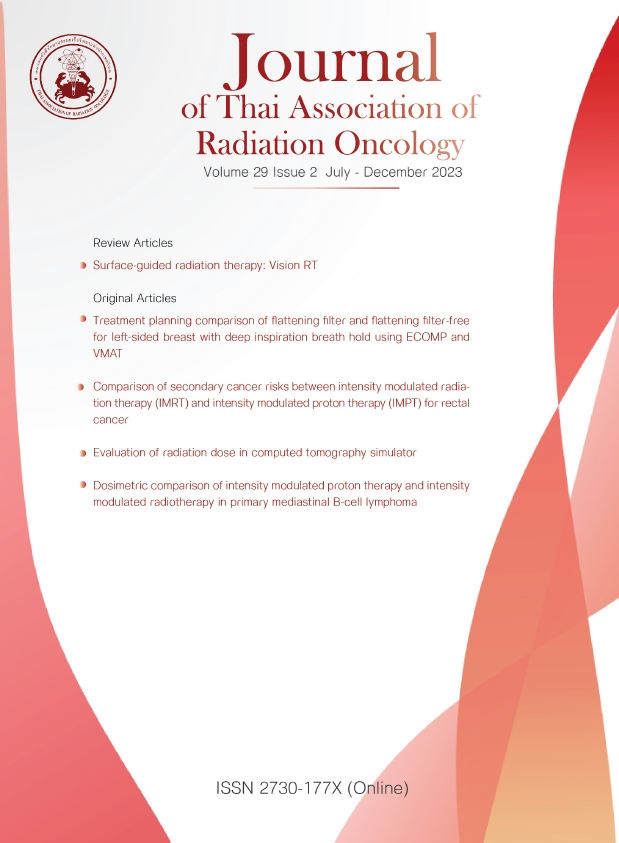Treatment planning comparison of flattening filter and flattening filter-free for left-sided breast with deep inspiration breath hold using ECOMP and VMAT
Keywords:
flattening filter free, volumetric modulated arc therapy, deep inspiration breath hold, left-sided breastAbstract
Background: The radiotherapy treatment planning with flattening filter-free (FFF) may reduce the treatment time because the dose rate is increased.
Objective: To compare the treatment planning between flattening filter (FF) and FFF for left-sided breast with deep inspiration breath hold (DIBH) using electronic tissue compensation (ECOMP) and volumetric modulated arc therapy (VMAT) techniques.
Materials and Methods: The treatment planning for left-sided breast with DIBH of FF-ECOMP, FFF-ECOMP, FF-VMAT, and FFF-VMAT were generated. The maximum dose rate was set at 600 and 1400 MU/min for 6 MV and 6 MV-FFF, respectively. The average dose in organs at risk (OARs) such as heart, ipsilateral lung, contralateral lung, left anterior descending artery, and contralateral breast was evaluated. The patient-specific QA was also checked by using the portal dosimetry. The total monitor unit (MU) and beam on time were observed.
Results: Most of the OARs showed higher doses in FFF-ECOMP. The doses in PTV and OARs were not significantly different between the FF-VMAT and FFF-VMAT. The total MU of the FF mode was significantly lower than the FFF mode. The delivery time of FF-ECOMP was longer than FFF-ECOMP by approximately 1.4 times. The %gamma passing rate of portal dosimetry for all techniques was higher than 95%.
Conclusion: The FFF mode was suitable for left-sided breast with DIBH treatment planning. The shortest to the longest delivery time following each technique were FFF-ECOMP, FF-ECOMP, FF-VMAT, and FFF-VMAT, respectively. The FFF-ECOMP showed a higher dose than FF-ECOMP in the organs at risk due to higher MU, but no difference in the VMAT for both FF and FFF modes.
References
Xiao Y, Kry SF, Popple R, Yorke E, Papanikolaou N, Stathakis S, et al. Flattening filter-free accelerators: a report from the AAPM Therapy Emerging Technology Assessment Work Group. J Appl Clin Med Phys. 2015;16:12-29.
Arslan A, Sengul B. Comparison of radiotherapy techniques with flattening filter and flattening filter-free in lung radiotherapy according to the treatment volume size. Sci Rep. 2020;10:8983.
Treutwein M, Hipp M, Koelbl O, Dobler B. Volumetric-modulated arc therapy and intensity-modulated radiation therapy treatment planning for prostate cancer with flattened beam and flattening filter free linear accelerators. J Appl Clin Med Phys. 2017;18:307-314.
Nagaraj J, Veluraja K. Is Synchronous Bilateral Breast Irradiation Using Flattening Filter-Free Beam-Based Volumetric-Modulated Arc Therapy Beneficial? A Dosimetric Study. J Med Phys. 2021;226-233.
Kumar SA, Musthafa MM, Suja CA, Resmi KB, Jose L, Muttath G, et al. Dosimetric comparison of FF and FFF beams in VMAT treatment plans of head and neck cancers. Onkol i Radioter. 2021;15:1-5.
Plaza DJ, Orzechowska KM, Slosarek KT. Effects of flattening filter (FF) and flattening filter-free (FFF) beams on small-field and large-field dose distribution using the VMAT treatment plan. Pol J Med Phys Eng. 2021;27:137-14.
พันทิวา อุณห์ศิริ, ชุลี วรรณวิจิตร, มนัญชยา วิมลโนช, ณิชกานต์ ชาติชำนาญ, ศักดา กิ่งแก้ว. การสำรวจปริมาณแกมมาและนิวตรอนหลังผ่านประตูเครื่องฉายรังสี TrueBEAM พลังงาน 10 MV ชนิดใช้และไม่ใช้ตัวกรองลำรังสี. J Thai Assoc Radiat Oncol. 2022;28:R1-11.
Zhang Q, Yu Li X, Hu GW, Chen JY, Wang ZJ, Ye SJ, et.al. Dosimetric comparison for volumetric modulated arc therapy and intensity- modulated radiotherapy on the left-sided chest wall and internal mammary nodes irradiation in treating post-mastectomy breast cancer. Radiol Oncol. 2013; 49:91-98.
Venjakob A, Oertel M, Hering DA, Moustakis C, Haverkamp U, Eich HT. Hybrid volumetric modulated arc therapy for hypofractionated radiotherapy of breast cancer: a treatment planning study. Strahlenther Onkol. 2021;197:296-307.
Koivumaki T, Heikkila J, Vaananen A, Koskela K, Sillanmaki S, Seppala J. Flattening filter free technique in breath-hold treatments of left-sided breast cancer: The effect on beam-on time and dose distributions. Radiother Oncol. 2016;118:194-198.
Jensen CA, Funderud M, Lervag C. Free breathing VMAT versus deep inspiration breath‐hold 3D conformal radiation therapy for early stage left‐sided breast cancer. J Appl Clin Med Phys. 2021;22:44-51.
Oonsiri P, Wisetrinthong M, Chitnok M, Saksornchai K, Suriyapee S. An effective patient training for deep inspiration breath hold technique of left-sided breast on computed tomography simulation procedure at King Chulalongkorn Memorial Hospital. Radiat Oncol J. 2019;37:201.
Takakura T, Koubuchi S, Uehara A, Tashima A, Hirose T, Kimura H, et al. Evaluation of beam-on time and number of breath-holds using a flattening-filter-free beam with the deep inspiration breath-hold method in left-sided breast cancer. Med Dosim. 2020;45:359-62.
Wisnoskie SB, Liang X, Wahl AO, Bennion NR, Granatowicz AD, Zhou S, et al. Using flattening filter free beams in electronic tissue compensation whole breast irradiation with deep inspiration breath hold. J. Appl. Clin. Med. Phys. 2020;21:280-7.
Oonsiri P, Nantavithya C, Lertbutsayanukul C, Sarsitthithum T, Vimolnoch M, Tawonwong T, et al. Dosimetric evaluation of photons versus protons in postmastectomy planning for ultrahypofractionated breast radiotherapy. Radiat Oncol. 2022;17:1-9.
Oonsiri P, Vannavijit C, Wimolnoch M, Suriyapee S, Saksornchai K. Estimated radiation doses to ovarian and uterine organs in breast cancer irradiation using radio-photoluminescent glass dosimeters (RPLDs). J. Med. Radiat. Sci. 202;68:167-74.
MacDonald SaC O. Breast contouring radcomp consortium I; 2016.
https:// www. rtog. org/ LinkC lick. aspx? filet icket ZeVB4 51KQ8 3M% 3d& tabidZ429. Accessed 18 June 2022.
Spruijt KH, Dahele M, Cuijpers JP, Jeulink M, Rietveld D, Slotman BJ, et al. Flattening filter free vs flattened beams for breast irradiation. Int J Radiat Oncol Biol Phys. 2013;85:506-13.
Kragl G, Baier F, Lutz S, Albrich D, Dalaryd M, Kroupa B, et al. Flattening filter free beams in SBRT and IMRT: dosimetric assessment of peripheral doses. Z Med Phys. 2011;21:91-101.
Downloads
Published
How to Cite
Issue
Section
License
Copyright (c) 2023 Thai Association of Radiation Oncology

This work is licensed under a Creative Commons Attribution-NonCommercial-NoDerivatives 4.0 International License.
บทความที่ได้รับการตีพิมพ์เป็นลิขสิทธิ์ของวารสารมะเร็งวิวัฒน์ ข้อความที่ปรากฏในบทความแต่ละเรื่องในวารสารวิชาการเล่มนี้เป็นความคิดเห็นส่วนตัวของผู้เขียนแต่ละท่านไม่เกี่ยวข้องกับ และบุคคลากรท่านอื่น ๆ ใน สมาคมฯ แต่อย่างใด ความรับผิดชอบองค์ประกอบทั้งหมดของบทความแต่ละเรื่องเป็นของผู้เขียนแต่ละท่าน หากมีความผิดพลาดใดๆ ผู้เขียนแต่ละท่านจะรับผิดชอบบทความของตนเองแต่ผู้เดียว




